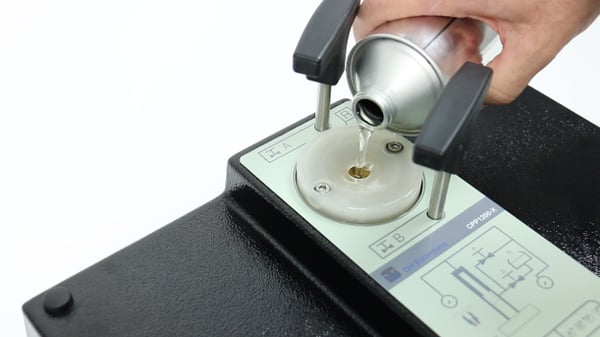At what pressure should you use pneumatic vs hydraulic media in a calibration?
Are there safety concerns when using either media?
What kind of fittings and tubing are used?
What kind of media should be used for each - which liquids or gasses?
There is a lot to think about when deciding how to design or augment a calibration program. Especially when dealing with a wide variety of pressure ranges - both high and low - where gas and liquid are being used in the process and as the medium for calibration. As always, safety is the primary concern. Safety is closely related to the pressure range and media that is planned or exists in your scope of calibration. Luckily, there are some conditions that influence the use of one media over the other.
 Hydraulic oil being poured into an instrument
Hydraulic oil being poured into an instrument
What Pressure – What Media??
The difference between high and low pressure is arbitrary. For pressure calibration components, high pressure usually refers to pressure ranges above 10,000 psi but is really a matter of opinion and the specific operating environment. It all depends on the scope of operation. If the highest range you have is 3,000 psi, that becomes your “high pressure.”
Generally speaking, pneumatic media is used to calibrate the majority of pressure sensors with ranges below 1,500 psi. Some specialized applications even require pneumatic media at higher pressures up to 10,000 psi. As pressure increases, hydraulic fluids become the dominant media, commonly water or oil. For reasons described below, it is safer to use hydraulic media at these higher pressure ranges. The capability to run pneumatic calibrations above 10,000 psi exists, but it is an exception and generally discouraged for safety reasons.
Safety
The energy stored in a container filled with air or non-volatile gas is a function of the pressure and the volume of the system. Pneumatic media, because of its compressibility, can store much more energy than hydraulic media. The higher the volume or pressure, the higher the energy that is stored and possibly released in the case of a breach. In a high-energy pneumatic system, sudden release of pressure into the atmosphere is best described as an explosion and can cause serious damage to life and property.
Luckily most calibration systems contain low volumes and therefore lower energy, but can still cause damage at close proximity to a breach. The potential for a containment failure of high energy systems is the main concern in safety. In a typical calibration system, the volume is low so the pressure would be the main variable of concern. For this reason, hydraulic media is typically used at pressures above 10,000 psi. However, when it is necessary to use pneumatic media above 10,000 psi, properly rated fittings and tubing must be selected to contain the gas within the system.
Fittings
The typical industrial fittings suitable for connecting calibration components containing both hydraulic and pneumatic media have an upper limit between 10,000 to 15,000 psi. Fittings intended for higher pressure systems can be used on low pressure systems as well. Fittings that rely on elastomeric seals must be compatible with the fluids used. Specially designed fittings for higher pressure typically have an upper limit of at least 60,000 psi. Most of these are compatible with hydraulic or pneumatic fluids at their rated pressures, however, careful selection with respect to pressure and media is critical.
Tubing
Pressure ratings for 1/4 inch OD (outer diameter) seamless, stainless steel tubing run from 4,000 to 10,300 psi, depending on the wall thickness. The typical fittings and tubing components used in industrial applications or calibration labs to contain pressure and convey fluids (both gas and liquid) generally have ratings up to and around 10,000 psi. Hardened stainless steel tubing can withstand pressure up to 60,000 psi. These tubing types are compatible with gasses and liquids.
Flexible nylon tubing is used extensively in calibration applications and has a working pressure rating of around 300 psi. Synthetic fiber reinforced flexible tubing is also used and has a rating of around 5,800 psi. Typically, flexible tubing is used for pneumatic media and stainless steel is used for hydraulic.
Compatibility
When a device is used in a process containing hydraulic media, it is generally more appropriate to calibrate it with hydraulic fluid. If it is calibrated with air or nitrogen, it must be thoroughly cleaned to prevent contamination of the pressure calibrator being used. Alternatively, when a device under test is used with a gas and calibrated with a liquid, it must be cleaned to prevent process contamination before it is put back into service. These things must be considered before a pneumatic or hydraulic medium is used as the calibration media.
Pneumatic Media Types
Pneumatic media in calibration applications are typically clean, dry air, or nitrogen. Other media, primarily inert gasses, can be used but are the exception as they are typically more expensive. Some inert gasses, like helium, may need to be avoided because of their high risk of leakage. Outside of specialized equipment and optimized calibration environments, gasses that are combustible should be avoided, including oxygen, which can cause spontaneous combustion of residual oil at high pressures. Most other gasses are rarely used in a calibration environment.
Hydraulic Media Types
Depending on the compatibility with the device being tested and the calibrator being used to produce the pressure, hydraulic media can be deionized water or oil. Many fluids can be used but compatibility with the device under test and the calibrator should be considered. Fluids such as distilled water, sebacate oil, HFE-7500, Shell Tellus-22, and others are common. The manufacturer of the calibration device should have specific recommendations for fluids.
Conclusion
The decision to use pneumatic or hydraulic media in a calibration application depends on many factors. Safety, in relation to equipment and personnel, is often the primary consideration. Pneumatic systems at high pressure pose a greater danger than hydraulic systems at the same pressure. Verified compatibility or thorough cleaning instructions must be considered when calibrating devices that are used with a different medium. Tubing, fittings, and seals must all be compatible with the media being used in order to ensure all safety risks are mitigated.
Related Reading:



